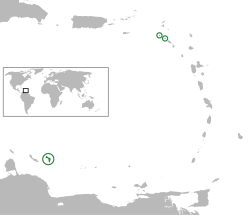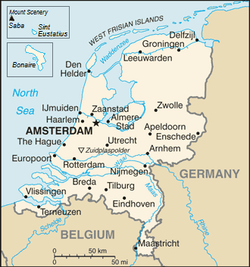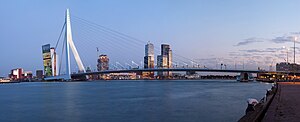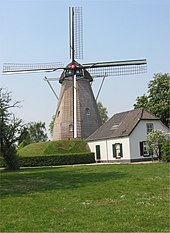Netherlands: Country in Northwestern Europe with territories in the Caribbean
Netherlands (or Holland) is a country that is part (of a constituent country) of the Kingdom of the Netherlands.
Most of it is in Western Europe, but there are also some parts in the Caribbean. Nearly 18 million people live there. To the north and west of the European part of the Netherlands is the North Sea, and to the east is Germany, and to the south is Belgium. The Netherlands is one of the countries that started the European Union. People who live in the Netherlands are called "Dutch". The language of the Netherlands is also called Dutch. The official capital of the Netherlands is Amsterdam. However, the government is in The Hague.
Netherlands Nederland (Dutch) | |
|---|---|
| Motto: "Je maintiendrai" (French) "Ik zal handhaven" (Dutch) "I will uphold" | |
| Anthem: "Wilhelmus van Nassouwe" (Dutch) "William of Nassau" | |
 Location of the European part of the Netherlands (dark green) – on the European continent (green & dark grey) | |
 Location of the Caribbean municipalities (green) | |
| Capital and largest city | Amsterdam 52°22′N 4°53′E / 52.367°N 4.883°E |
| Government seat | The Hague |
| Official languages | Dutch |
| Co-official languages | |
| Recognized regional languages | |
| Ethnic groups (2017) |
|
| Religion (2016) |
|
| Demonym(s) | Dutch |
| Sovereign state | Kingdom of the Netherlands |
| Government | Unitary parliamentary constitutional monarchy |
• Monarch | Willem-Alexander |
| Mark Rutte | |
• Deputy Prime Ministers |
|
• Vice President of the Council of State | Thom de Graaf |
| Legislature | States General |
| Senate | |
| House of Representatives | |
| Independence from Habsburg Spain | |
• Proclaimed | 26 July 1581 |
| 30 January 1648 | |
• Kingdom established | 16 March 1815 |
• Liberation Day | 5 May 1945 |
| 10 December 1945 | |
• Charter | 15 December 1954 |
| 10 October 2010 | |
| Area | |
• Total | 41,543 km2 (16,040 sq mi) (131st) |
• Water (%) | 18.41 (as of 2023) |
| Population | |
• 2023 census | 17,811,291 |
• Density | 429/km2 (1,111.1/sq mi) (16th) |
| GDP (PPP) | 2019 estimate |
• Total | $1.004 trillion (28th) |
• Per capita | $58,255 (13th) |
| GDP (nominal) | 2019 estimate |
• Total | $914 billion (17th) |
• Per capita | $53,016 (13th) |
| Gini (2019) | low · 15th |
| HDI (2018) | very high · 10th |
| Currency | |
| Time zone | |
• Summer (DST) | |
| Note: Even though the European Netherlands are located within the UTC±0 longitudes, the country adopted UTC+1 (Central European Time) as its standard time under German occupation on 2 November 1942, with a +0:40:28 offset (+1:40:28 during DST) from Amsterdam’s LMT (UTC+0:19:32). | |
| Date format | dd-mm-yyyy |
| Mains electricity | 230 V–50 Hz |
| Driving side | right |
| Calling code | +31, +599 |
| ISO 3166 code | NL |
| Internet TLD | .nl, .bq |
 | |
Name
"The Netherlands" means "the low lands". The land only rises, on average, 1 meter above sea level. One third of the land is below sea level. The Netherlands is also - incorrectly - referred to as Holland. Holland is a very rich area (two provinces) in the western part of the Netherlands, thus causing people to be mistaken. Most people who do not live in the western part of the Netherlands do not like it when people call the country Holland. The name "Holland" originates from the old Dutch words "Holt land" which means "wood lands". Holt eventually changed into hout, the current Dutch word for wood.
History
At the end of the Middle Ages the dukes of Burgundy, a country that is now part of France, united seventeen areas. Those areas were called the Netherlands. When the daughter of a duke married Maximilian I, Holy Roman Emperor in 1477, the Netherlands became part of Spain. In the 16th century many Dutch people became Protestant. The king of Spain did not like it, he wanted all Dutch to be Roman Catholic. Of course the Dutch people did not like this, and after violent excesses by the Spanish they started a war against Spain in 1568, also for reasons of taxation. The war lasted until 1648, therefore it is called the Eighty Years' War. An important leader of the Dutch in this war was Willem van Oranje (William of Orange) also called William the Silent.
In 1648 the Netherlands and Spain signed peace. The Dutch people were allowed to keep all the areas they conquered. The part of the Netherlands that was not conquered by the Dutch stayed part of Spain. Later this part became the country Belgium.
When the Netherlands became independent, it was a very special country. That time almost all countries in Europe were ruled by a king, but the Netherlands was a republic. The Netherlands was made up of seven provinces, that were ruled by the big cities. The cities were ruled by the municipality which consisted of rich civilians. Together those provinces were ruled by a stadtholder, a very powerful man, but compared to the kings of other European countries he had much less power.
In the 17th century the Netherlands was the richest and one of the most powerful countries in the world. Therefore, the Dutch call the 17th century the Golden Age. Their Dutch Empire had colonies around the world. One important colony was the East Indies, which is now called Indonesia. They also had colonies in the Caribbean, like the other European empires. They also started New Netherland, which is now called New York. The Netherlands often fought wars against other European countries, especially the Anglo-Dutch Wars against England. Michiel de Ruyter, a Dutch admiral, became a Dutch hero when he defeated the English navy close to London.
In the 18th century the Netherlands became poorer. Many people blamed this on the government leaders, the stadtholders. Many thought they had too much power and wanted them to get away. In 1789 the French people deposed (got rid of) their king. French armies attacked other countries to depose their leaders too. In 1795 they attacked the Netherlands. Stadtholder William V had to flee to England. The Netherlands were renamed to Batavian Republic and became a democracy. But the French were not content (satisfied) with the Dutch ruler, so in 1806 the French emperor Napoleon made his brother Louis Bonaparte king of the Netherlands. Louis became popular in the Netherlands, but the emperor was again not content with him, so in 1810 the Netherlands became a part of France.
In 1815 Napoleon was defeated, and the Netherlands became independent again. The rulers of European countries thought it was a good idea to make the Netherlands stronger, to make them able to resist another French invasion. Therefore, Belgium and Luxembourg were added to the Netherlands. William I, the son of stadtholder William V, became king. Some Belgians disliked their Dutch king. In 1830 they revolted. William sent an army. He was much more powerful than the Belgians but after ten days the French sent an army to support them. In 1831 the Belgians chose their own king and Belgium became an independent country.
Some people again thought the Dutch king had too much power. They wanted to give him less power and vote for the government themselves. In 1848 there were violent revolts against the kings of many European countries. The Dutch king was afraid the same would happen in the Netherlands. Therefore, he allowed Johan Rudolf Thorbecke to write a constitution. From then on people were allowed to vote. At first only rich men were allowed to vote. From 1919 on all adults were allowed to vote.
In World War I, the Netherlands did not fight and were not invaded. The Dutch wanted to stay neutral in World War II as well, but in 1940 the country was invaded and occupied by Germany. Like in other countries they had occupied, the German authorities started to kill Jews. Anne Frank was a Jewish girl who lived in the Netherlands. Her family hid from the Nazis and she wrote a diary. She died in a Nazi concentration camp and her diary became famous.
In 1944 the American, Canadian, Polish and British armies liberated the south of the Netherlands from Nazi Occupation. They wanted to cross the Rhine river in Operation Market Garden to liberate the rest of the country, but they were defeated. It took until May 1945 before the entire country was liberated. During the five years of Nazi occupation, 250,000 people had died in the Netherlands.
Shortly after the war, Indonesia declared its independence. The Dutch sent soldiers to fight in Indonesia. After other countries, including the United States, told the Dutch to leave Indonesia, they finally did so in 1949.
After the war the Netherlands became one of the richest countries in the world. In 2004 the United Nations said that the Netherlands was the 5th best country to live in.
Politics
The Netherlands is a constitutional monarchy. That means the country has a king, but the real power is in the hands of a parliament, chosen by the Dutch people. All Dutch people at least 18 years old or older are allowed to vote. The Dutch parliament consists of two chambers: the Second Chamber (Dutch: Tweede Kamer, this is the House of Representatives, elected every four years), and the First Chamber (Dutch: Eerste Kamer, this is the Senate, elected by provincial politicians every four years). After the Second Chamber elections, parties that have had a majority of the votes create a cabinet. The cabinet consists of a prime minister and several other ministers and deputy ministers. Current cabinet is the liberal-Christian democratic Fourth Rutte cabinet, consisting of VVD, D66, CDA, and CU politicians. Prime Minister is Mark Rutte (VVD). This cabinet fell on 7 July 2023 and is taking care for the time being until a new cabinet has been installed.
The latest general elections were held on 22 November 2023. Winners were populist party PVV, leftist alliance GL-PvdA, and centrist parties NSC and BBB. Losers were liberal parties VVD and D66, leftist parties SP and PvdD, Christian democratic parties CDA and CU, populist parties FVD and JA21, and European party Volt Netherlands.
The Netherlands is known for tolerance in politics. The Netherlands is the only country where soft drugs are not entirely considered illegal. Furthermore, the Netherlands is one of the few countries that allow same-sex marriages, euthanasia and prostitution to a certain extent.
More information: Politics of the Netherlands.
Subdivisions
The Netherlands is subdivided in provinces and municipalities.
Provinces

In the Netherlands there are 12 provinces:
|
These provinces are all located in the part of the Netherlands that is in Europe. The country also includes three special municipalities in the Caribbean: Bonaire, Saba and Sint Eustatius. They are not part of any province, but together are known as the Caribbean Netherlands. The Netherlands (both the European part and the Caribbean Netherlands), together with Aruba, Curaçao and Sint Maarten, also in the Caribbean, form a sovereign state called the Kingdom of the Netherlands.
When the Kingdom was formed in 1954, the territories in the Caribbean became part of the Netherlands Antilles. At that time it also included Suriname in South America, which became an independent country in 1975. Aruba left the Antilles in 1986, and Curaçao and Sint Maarten did the same in 2010. The rest of the islands then became the Caribbean Netherlands which is part of the Netherlands proper.
Municipalities
The Netherlands has 342 municipalities (2023) and also three special municipalities in the so-called Caribbean Netherlands.
Almost every year the amount of municipalities decrease.
Cities
Cities aren't actually a subdivision of the Netherlands. Cities are also municipalities or they make part of municipalities.
This is a list of the cities/municipalities with over 100,000 people.





For all municipalities with more population numbers,
see: List of municipalities of the Netherlands.
Geography
In fact a large part of the Netherlands (the province Flevoland) was created by the sand that came from the many rivers flowing through it. Notable Dutch rivers are the Rhine, the Maas, the IJssel and the Scelt. A large part of the Netherlands is below sea level. This is because the Dutch have made many lakes and parts of the sea dry, creating polders. Therefore, there is a saying "God created the earth, but the Dutch created the Netherlands." This makes the Netherlands very flat. In the very south-east of the Netherlands, in Limburg, there are some hills. Therefore, this region is a tourist-attraction for many Dutch people. The highest point in the European portion of the Netherlands, the Vaalserberg, is 323 metres above sea level. The highest point in both the Netherlands proper and the Kingdom of the Netherlands is Mount Scenery, on the Caribbean island of Saba, at 887 metres.
The Netherlands is a small flat country; about 300 kilometers from north to south, and about 170 kilometers from east to west. It has an oceanic climate (Cfb in the Köppen climate classification).
Climate
The Netherlands has an oceanic climate, with a yearly average temperature of 10 °C (50 °F).
The highest temperature ever recorded in the Netherlands was 40.7 °C (105.3 °F), on 25 July 2019 in Gilze-Rijen.
The lowest temperature ever recorded in the Netherlands was −27.4 °C (−17.3 °F), on 27 January 1942 in Winterswijk.
Top 5 warmest days
| Rank | Temperature | Date | Location |
|---|---|---|---|
| 1. | 40.7 °C (105.3 °F) | 25 July 2019 | Gilze-Rijen |
| 2. | 40.1 °C (104.2 °F) | 26 July 2019 | Volkel |
| 3. | 39.5 °C (103.1 °F) | 19 July 2022 | Maastricht-Aachen Airport |
| 4. | 39.3 °C (102.7 °F) | 24 July 2019 | Eindhoven |
| 5. | 38.2 °C (100.8 °F) | 26 July 2018, 2 July 2015 | Arcen, Maastricht-Aachen Airport |
People

The Netherlands is a small country, but many people live there. It is one of the most densely populated countries of the world.
Most people in the Netherlands speak Dutch. In Friesland, about 200,000 people speak Frisian. Frisian is the language with the most similarities to English. Some Dutch people speak dialects. The Saxon dialects spoken in the northeastern part of the Netherlands are somewhat similar to Low German.
According to a survey done in 2010, 23% of the Dutch people are Christian and 6% is islam and 71% believe in another organised religion, like Judaism, Islam or Hinduism. Twenty-six percent are 'unbounded spiritual' (have their own beliefs and are not tied to a religion). The other 44% are not religious.
Significant minorities in the country include Turkish people 700,000, Jews 41,000-45,000 and Roma and Sinti 40,000.
Trains
Nederlandse Spoorwegen (English: Dutch Railways) or NS is the main passenger railway operator in the Netherlands. The rail infrastructure is maintained by network manager ProRail, which was split from NS in 2003. Freight services, formerly operated by NS Cargo, merged with the DB Schenker group in 2000.
NS runs 4,800 scheduled trains daily. In addition, NS provides international rail services from the Netherlands to other European destinations and carries out concessions on a number of foreign rail markets through its subsidiary Abellio such as Abellio Greater Anglia, Merseyrail and ScotRail.
Arriva is another passenger railway operator in the Netherlands. It is a subsidiary of the German company Deutsche Bahn. Their local headquarters is based at Heerenveen. They have been active since 1998.
Related pages
References
Notes

This article uses material from the Wikipedia Simple English article Netherlands, which is released under the Creative Commons Attribution-ShareAlike 3.0 license ("CC BY-SA 3.0"); additional terms may apply (view authors). Content is available under CC BY-SA 4.0 unless otherwise noted. Images, videos and audio are available under their respective licenses.
®Wikipedia is a registered trademark of the Wiki Foundation, Inc. Wiki Simple English (DUHOCTRUNGQUOC.VN) is an independent company and has no affiliation with Wiki Foundation.
























